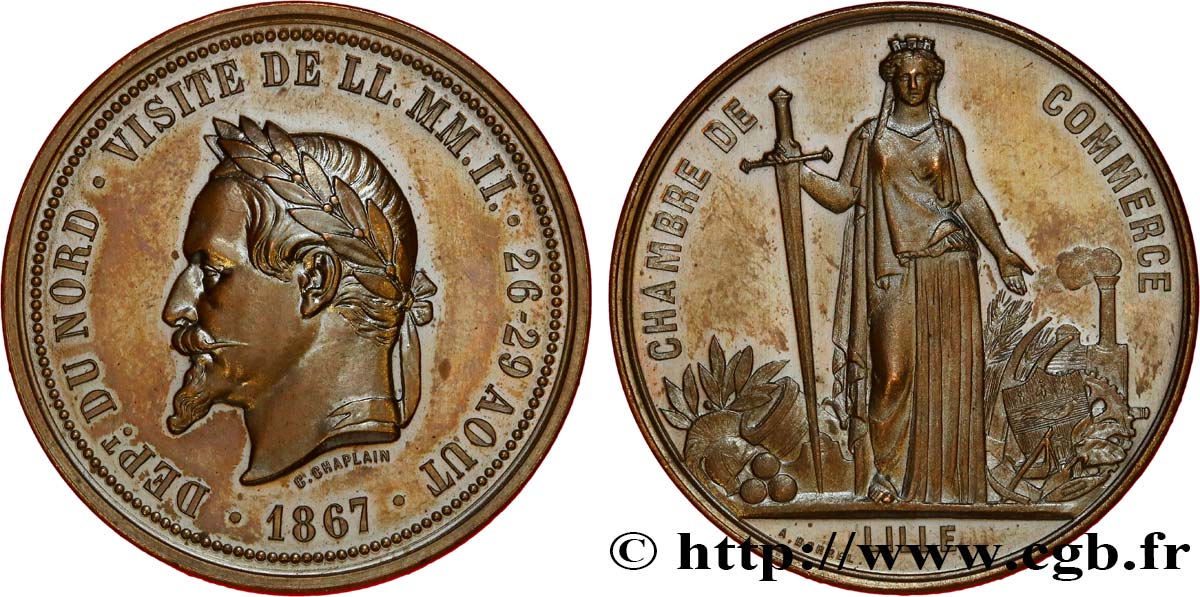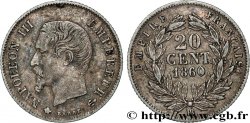E-auction 323-240161 - fme_380847 - SECOND EMPIRE Médaille de visite - Chambre de commerce
Чтобы принять участие в торгах, вы должны войти в систему и стать подтвержденным участником аукциона. Войдите, чтобы сделать ставку. Ваш аккаунт будет подтвержден в течение 48 часов. Не ждите до закрытия торгов, чтобы зарегистрироваться.Сделав ставку на данный товар, вы вступаете в юридическое соглашение на покупку выбранного товара и нажатием кнопки «Сделать ставку» подтверждаете принятие вами условий интернет-аукционов cgb.fr.
Ставка может бить сделана только в полном эквиваленте евро. Торги закроются согласно времени, указанному в описании товара, все ставки, сделанные после закрытия торгов, учитываться не будут. Не следует откладывать предложение вашей ставки до последнего момента, так как система может не успеть обработать вашу заявку, и ваша ставка не будет принята. Более детальную информацию вы найдёте здесь: FAQ по интернет-аукционам.
БЕСПЛАТНО.
БЕСПЛАТНО.
| Оценить : | 50 € |
| Цена : | 19 € |
| Максимальная предлагаемая цена : | 20 € |
| Конец торгов : | 24 June 2019 18:11:00 |
| Участников : | 8 Участников |
Тип Médaille de visite - Chambre de commerce
Дата: 1867
Монетный двор / Город: 59 - Lille
Металл: copper
Диаметр: 36,5 mm
Ориентация осей монеты: 12 h.
Гравер CHAPLAIN Jules (1839-1909) / BORREL Alfred (1836-1927)
Вес: 20,12 g.
Век: lisse + abeille CUIVRE
Пуансон: Abeille CUIVRE
Комментарии о состоянии
Petite patine irisée dans les champs. Bel aspect malgré quelques traces de manipulation dans les champs
Ссылки в каталоге: :
Лицевая сторона
Аверс: легенда: DEPT. DU NORD. VISITE DE LL. MM. II. 26-29 AOÛT. / 1867.
Аверс: описание: Tête laurée de Napoléon III à gauche; signé : C. CHAPLAIN.
Обратная сторона
Реверс: легенда: CHAMBRE DE - COMMERCE // LILLE.
Реверс: Описание: Allégorie féminine de la ville de Lille tenant une épée devant un décor de casque grec, mortier et boulets, armoirie, blé et charrue, locomotive et matériel de mineur; signé : A. BORREL.
Комментарий
Jules Clément Chaplain est un médailliste parisien né à Mortagne en 1839, mort en 1909. Il a étudié auprès du graveur Eugène Oudiné et est allé à l’école des Beaux Arts en 1857. Il obtient en 1860 le second prix de Rome, puis le premier prix en 1863. Il continua ses études en Italie jusqu’en 1868. Il reçoit la légion d’honneur en 1878 et officier en 1888. Il signe les 5, 10 et 20 Francs coq Marianne.
Il est intéressant de noter que le graveur Jules Clément Chaplain signe C. CHAPLAIN au droit alors qu’il signera par la suite J. CHAPLAIN, J. C. CHAPLAIN et J. C. C.
Alfred Borrel, médailliste, fils de Valentin Maurice Borrel, est né en 1836 à Paris et mort en 1927. Il est élève des Beaux Arts en 1856 et gagne le second Grand Prix de Rome en 1860.
Sources : Forrer L., Biographical dictionary of medaillist.
Jules Clément Chaplain was a Parisian medalist born in Mortagne in 1839 and died in 1909. He studied with the engraver Eugène Oudiné and attended the École des Beaux-Arts in 1857. He was awarded the second prize of Rome in 1860, then the first prize in 1863. He continued his studies in Italy until 1868. He received the Legion of Honour in 1878 and an officer in 1888. He signed the 5, 10 and 20 Francs rooster Marianne. It is interesting to note that the engraver Jules Clément Chaplain signs C. CHAPLAIN on the obverse while he will subsequently sign J. CHAPLAIN, JC CHAPLAIN and JCC Alfred Borrel, medallist, son of Valentin Maurice Borrel, was born in 1836 in Paris and died in 1927. He was a student of the Beaux Arts in 1856 and won the second Grand Prix de Rome in 1860. Sources: Forrer L., Biographical dictionary of medallist
Il est intéressant de noter que le graveur Jules Clément Chaplain signe C. CHAPLAIN au droit alors qu’il signera par la suite J. CHAPLAIN, J. C. CHAPLAIN et J. C. C.
Alfred Borrel, médailliste, fils de Valentin Maurice Borrel, est né en 1836 à Paris et mort en 1927. Il est élève des Beaux Arts en 1856 et gagne le second Grand Prix de Rome en 1860.
Sources : Forrer L., Biographical dictionary of medaillist.
Jules Clément Chaplain was a Parisian medalist born in Mortagne in 1839 and died in 1909. He studied with the engraver Eugène Oudiné and attended the École des Beaux-Arts in 1857. He was awarded the second prize of Rome in 1860, then the first prize in 1863. He continued his studies in Italy until 1868. He received the Legion of Honour in 1878 and an officer in 1888. He signed the 5, 10 and 20 Francs rooster Marianne. It is interesting to note that the engraver Jules Clément Chaplain signs C. CHAPLAIN on the obverse while he will subsequently sign J. CHAPLAIN, JC CHAPLAIN and JCC Alfred Borrel, medallist, son of Valentin Maurice Borrel, was born in 1836 in Paris and died in 1927. He was a student of the Beaux Arts in 1856 and won the second Grand Prix de Rome in 1860. Sources: Forrer L., Biographical dictionary of medallist








 Cообщить об ошибке
Cообщить об ошибке Распечатать страницу
Распечатать страницу Отправить мой выбор
Отправить мой выбор Задать вопрос
Задать вопрос Consign / sell
Consign / sell
 Информация
Информация










